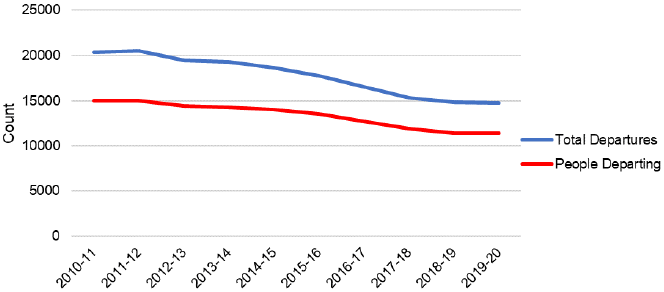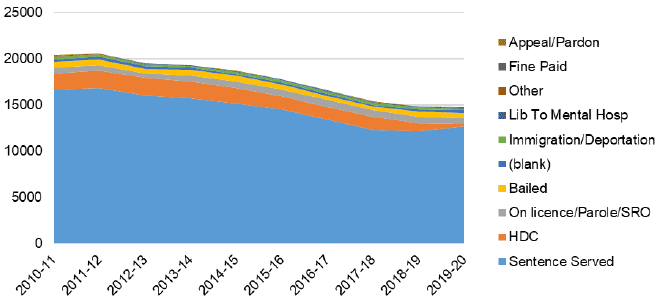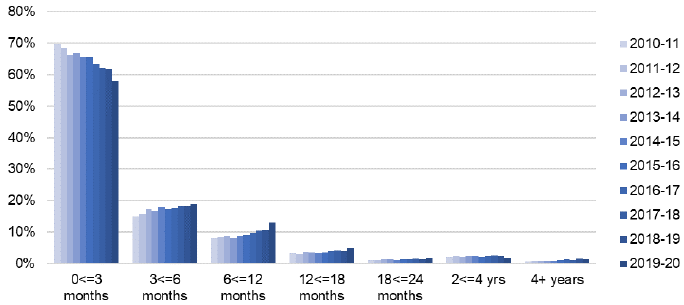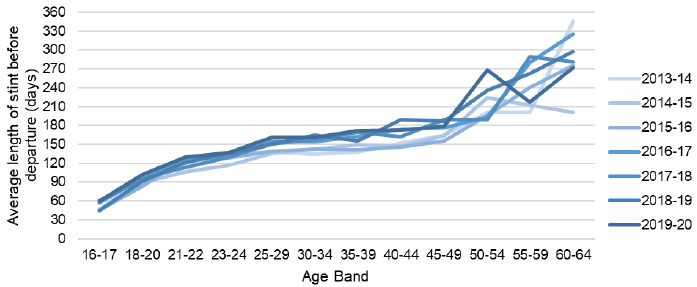Scottish prison population: statistics 2019 to 2020
This publication explores the characteristics of imprisoned people in Scotland. Following several years of sustained decrease, the prison population has risen sharply since 2017-2018 to an annual average of around 8,200 in 2019-2020.
4 Departures
In this section we look at the individuals who leave prison for one night or more: on what basis they have been released, and for how long they had been incarcerated up to that point.
4.1 Total Departures & Individuals Departing
(Data table B2)
The number of individuals departing prison one or more times in a year fell 24% over the past decade, from 15,038 in 2010-11 to 11,457 in 2019-20 (Figure 11).
A single individual can depart prison multiple times within a year. However the proportion of individuals doing so has fallen over the past decade. In 2010-11, 25% had two or more departures, while by 2019-20 this had fallen to 21%. This is likely due to the observed reduction in short custodial sentences.[13]
As a result, the total number of departures has fallen faster than the number of individuals departing: 28% over the past decade, from 20,364 in 2010-11 to 14,741 in 2019-20.

Because a prisoner may depart prison multiple times in a year, for different reasons and having served different time periods, in the remainder of this section we count departures permitting the double-counting were people depart more than once in a year.
4.2 Liberations
(Data table C1)
In 2019-20, 86% of departures from prison were due to the prisoner's sentenced being expired. This had increased from previous years, when it was typically around 82% (Figure 12). This is likely due to prisoners not being released as early as they might have been in previous years.
Between 2010-11 and 2017-18, around 8% to 10% of departures were prisoners leaving on home detention curfew (HDC)[14]: between 1,400 and 2,000 departures per year. Due to a change in directive on granting release on HDC, by 2019-20 this proportion had dropped to around 1% of departures, with only 196 in 2019-20.

The reduction in release on HDC coincides with the growing average prison population between 2018-19 and 2019-20. Although unlikely to be the sole factor at play, reducing avenues for early release from prison increases the length of time an individual will spend in custody and therefore contributes to increases in the full-year population (see section 5).
For further information on the different types of departure listed above, see section 6.3.
4.3 Overall Time in Custody
(Data table C2)
It is not yet possible to compile information about sentence length, legal status or offence type in this developing statistical source. However, it is possible to indicate trends in sentencing based on how long an individual serves prior to their departure from prison.
It should be noted that the length of a stint in prison does not, in most cases, equate to the length of sentence they have received. On short term sentences (less than 4 years), prisoners are typically eligible for release at the half-way point of their sentence. Some individuals spend time in prison unsentenced - ie. on remand. Whether this time spent on remand counts towards time served on a sentence varies between cases, which will change the total time an individual serves in prison for a given sentence.
Between 2010-11 and 2019-20, the proportion of individuals who depart prison having served up to 3 months fell from 70% to 58% (Figure 13). The proportion who served a year or more went from 7% of departing prisoners in 2010-11 to 10% in 2019-20.

4.3.1 Average length of stint by age
(Data table C3)
The length of time an individual has spent in prison prior to their departure[15] is somewhat correlated with that prisoner's age. Figure 14 shows this relationship across age bands: older individuals departing prison typically serve longer stints than younger people.
Older people departing prison spent longer on average in prison than younger people. The ageing population of prisons is therefore amplified when viewed in terms of daily average populations rather than in terms of people imprisoned.[16]

Contact
Email: justice_analysts@gov.scot
There is a problem
Thanks for your feedback